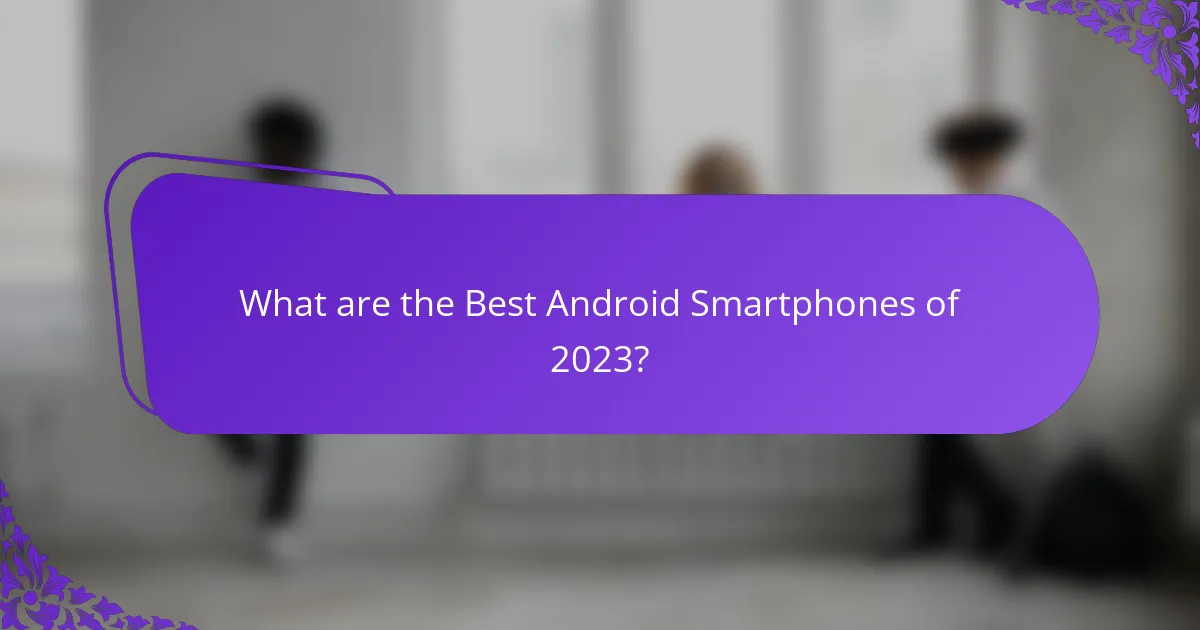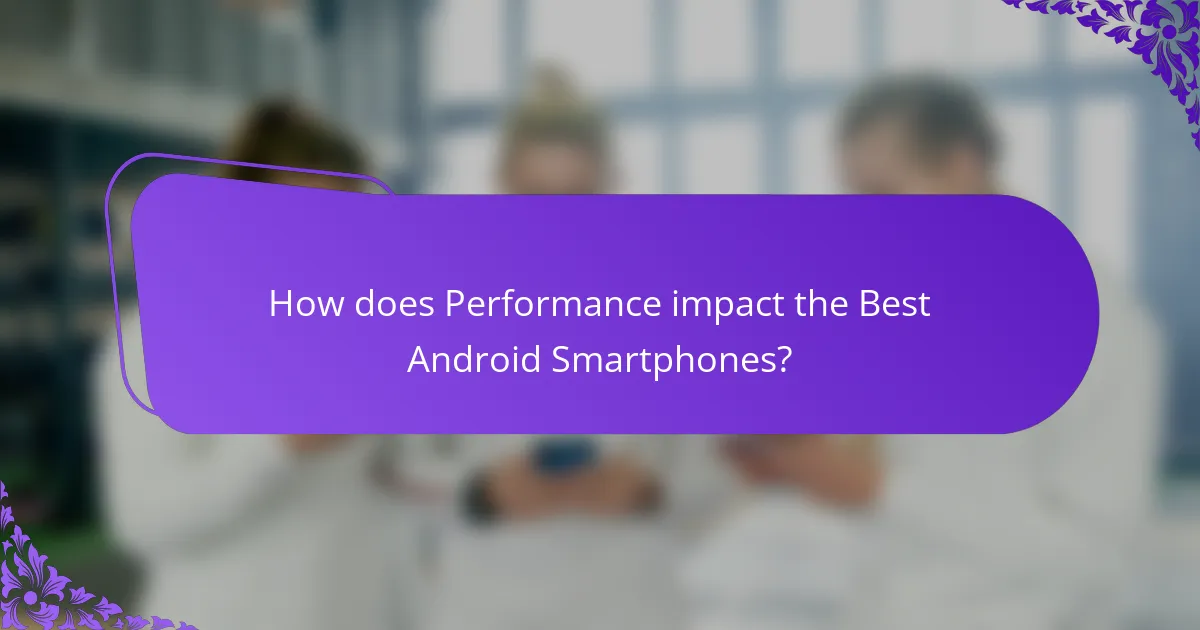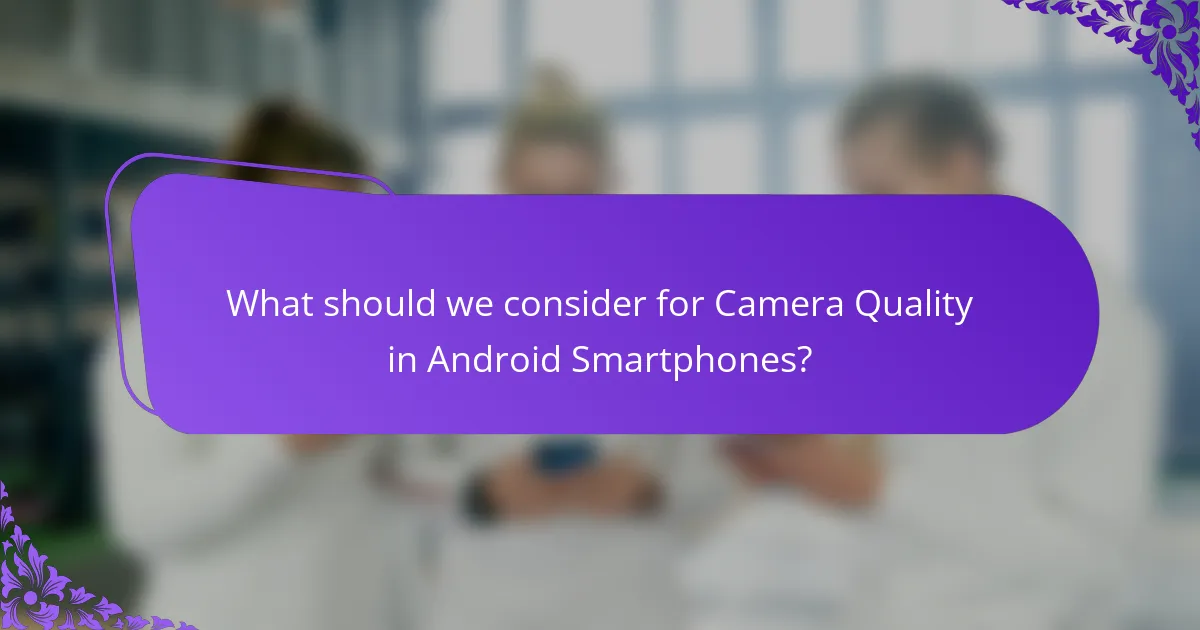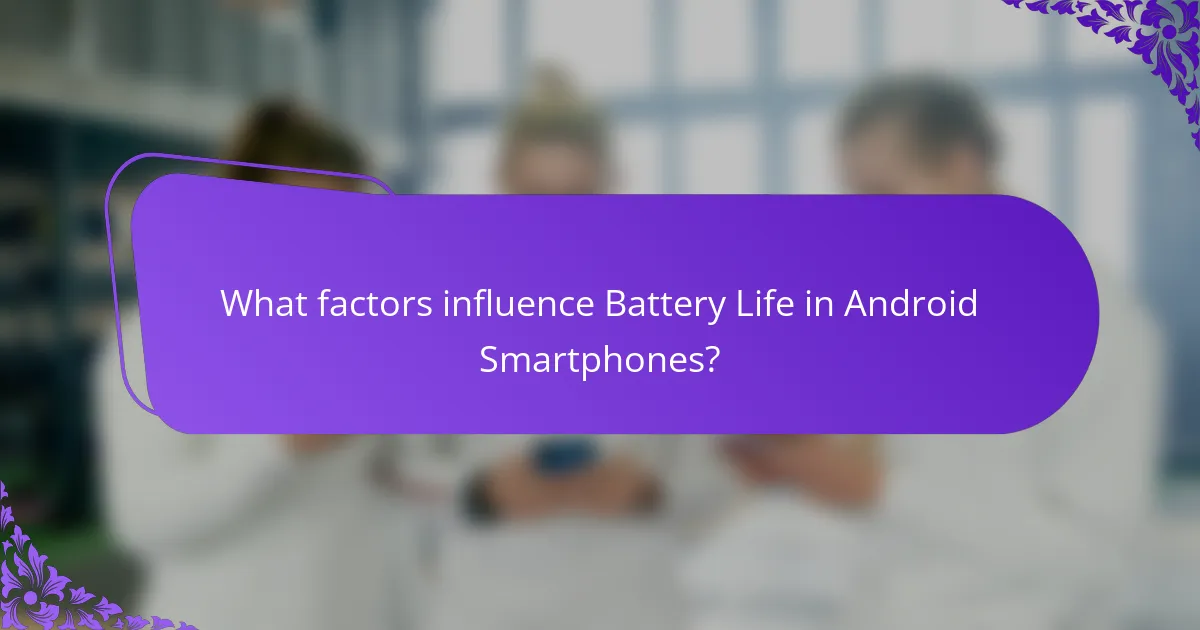The best Android smartphones of 2023 include the Samsung Galaxy S23 Ultra, Google Pixel 7 Pro, and OnePlus 11, each excelling in performance, camera quality, and battery life. The Samsung Galaxy S23 Ultra features a 200 MP camera and a Snapdragon 8 Gen 2 processor, offering exceptional speed and over a day of battery life. The Google Pixel 7 Pro is renowned for its advanced computational photography and stock Android experience, powered by the Tensor G2 chip. The OnePlus 11 combines a powerful Snapdragon 8 Gen 2 processor with a 50 MP main camera and fast charging capabilities. This article will explore the critical factors influencing smartphone performance, camera quality, and battery longevity, providing insights into what makes these models top choices for Android users.

What are the Best Android Smartphones of 2023?
The best Android smartphones of 2023 include the Samsung Galaxy S23 Ultra, Google Pixel 7 Pro, and OnePlus 11. The Samsung Galaxy S23 Ultra features a 200 MP camera and a Snapdragon 8 Gen 2 processor. It offers exceptional performance and battery life, lasting over a day on a single charge. The Google Pixel 7 Pro is known for its outstanding camera capabilities and stock Android experience. It includes advanced computational photography features and a Tensor G2 chip. The OnePlus 11 provides a powerful Snapdragon 8 Gen 2 processor and a 50 MP main camera. It delivers a fast charging experience with a 5000 mAh battery. These models excel in performance, camera quality, and battery life, making them top choices for Android users in 2023.
How do we define ‘best’ in the context of Android smartphones?
The ‘best’ in the context of Android smartphones is defined by a combination of performance, camera quality, and battery life. Performance is measured through processor speed, RAM, and software optimization. Camera quality is assessed by resolution, lens versatility, and low-light performance. Battery life is evaluated based on capacity, charging speed, and real-world usage duration. These criteria are supported by expert reviews and user feedback. For example, smartphones like the Samsung Galaxy S23 Ultra excel in these areas, receiving high ratings in performance benchmarks and camera tests.
What criteria are used to evaluate performance, camera quality, and battery life?
Performance is evaluated based on processor speed, RAM capacity, and software optimization. Camera quality is assessed using megapixel count, aperture size, and image processing capabilities. Battery life is measured by battery capacity in milliampere-hours (mAh) and real-world usage tests. For example, a smartphone with a Snapdragon 888 processor and 8 GB of RAM typically shows superior performance. Similarly, a camera with a 108 MP sensor often captures more detail. A device with a 4500 mAh battery usually lasts longer than one with a 3000 mAh battery under similar usage conditions. These criteria provide a comprehensive evaluation of smartphones in these key areas.
How do different brands compare in these criteria?
Different brands of Android smartphones vary significantly in performance, camera quality, and battery life. For instance, Samsung’s Galaxy series often excels in camera quality with high-resolution sensors and advanced image processing. In terms of performance, brands like OnePlus and Xiaomi frequently offer flagship-level processors at competitive prices. Battery life is a strong point for brands such as Motorola, which emphasizes large-capacity batteries in many models.
According to a 2023 review by TechRadar, Samsung leads in camera technology, while OnePlus is noted for its fast charging capabilities. A study by GSMArena highlights that Xiaomi devices often provide better performance benchmarks due to optimized software. Additionally, Consumer Reports indicates that Motorola smartphones generally have longer battery longevity compared to competitors.
What are the top contenders for the best Android smartphones in 2023?
The top contenders for the best Android smartphones in 2023 include the Samsung Galaxy S23 Ultra, Google Pixel 7 Pro, and OnePlus 11. The Samsung Galaxy S23 Ultra features a powerful Snapdragon 8 Gen 2 processor and a 200 MP camera. Its battery capacity is 5000 mAh, providing excellent longevity. The Google Pixel 7 Pro is known for its exceptional camera performance with advanced computational photography. It runs on Google’s Tensor G2 chip, optimizing software and hardware integration. The OnePlus 11 offers a fast charging capability with a 100W charger and a Snapdragon 8 Gen 2 processor. Each of these models excels in performance, camera quality, and battery life, making them top choices in 2023.
Which models are leading in performance?
The leading models in performance for Android smartphones in 2023 include the Samsung Galaxy S23 Ultra, Google Pixel 7 Pro, and OnePlus 11. The Samsung Galaxy S23 Ultra features the Snapdragon 8 Gen 2 processor, delivering exceptional speed and efficiency. The Google Pixel 7 Pro utilizes Google’s Tensor G2 chip, optimizing AI and machine learning tasks effectively. The OnePlus 11 is powered by the Snapdragon 8 Gen 2 as well, offering robust performance in gaming and multitasking. These models consistently rank high in benchmark tests, demonstrating their superior processing capabilities.
What smartphones excel in camera quality?
The smartphones that excel in camera quality include the Samsung Galaxy S23 Ultra, Google Pixel 7 Pro, and iPhone 14 Pro. The Samsung Galaxy S23 Ultra features a 200 MP main camera, offering exceptional detail and clarity. Its advanced zoom capabilities enhance versatility in photography. The Google Pixel 7 Pro is known for its computational photography, delivering stunning images in various lighting conditions. Its 50 MP main sensor captures vibrant colors and sharp details. The iPhone 14 Pro boasts a triple-camera system with a 48 MP main sensor, providing high-quality images and excellent low-light performance. Each of these smartphones has received high ratings from industry experts for their camera capabilities.
Which devices offer the best battery life?
The devices offering the best battery life in 2023 include the Samsung Galaxy M32, Asus ROG Phone 5, and Xiaomi Redmi Note 10. The Samsung Galaxy M32 features a 6000 mAh battery, providing extensive usage time. The Asus ROG Phone 5 is equipped with a 6000 mAh battery as well, designed for gamers needing long-lasting power. The Xiaomi Redmi Note 10 has a 5000 mAh battery, ensuring reliable performance throughout the day. These devices consistently receive high ratings for battery longevity in user reviews and tech assessments.

How does Performance impact the Best Android Smartphones?
Performance significantly impacts the best Android smartphones by determining their speed and responsiveness. High-performance smartphones provide seamless multitasking capabilities. They enable quick app launches and smoother gaming experiences. Performance is often measured by processors, RAM, and GPU quality. For instance, flagship models typically feature Snapdragon 8 Gen 1 or Exynos 2200 processors. These processors deliver superior computational power and graphics rendering. A study by AnTuTu in 2023 indicated that higher performance scores correlate with user satisfaction. Users report faster performance leads to enhanced productivity and entertainment experiences. Thus, performance is a crucial factor in evaluating the best Android smartphones.
What specifications are crucial for smartphone performance?
Crucial specifications for smartphone performance include the processor, RAM, storage, battery capacity, and display quality. The processor determines the speed and efficiency of tasks. For example, Snapdragon 8 Gen 1 offers high performance for gaming and multitasking. RAM impacts the ability to run multiple applications simultaneously. Devices with 8GB or more RAM provide smoother experiences. Storage capacity affects how much data can be stored. Options of 128GB or higher are recommended for heavy users. Battery capacity, measured in mAh, influences usage time. Smartphones with 4500 mAh or more typically last longer on a single charge. Finally, display quality, including resolution and refresh rate, enhances visual experience. A 1080p resolution with a 120Hz refresh rate is ideal for fluid visuals.
How does processor speed influence overall performance?
Processor speed significantly influences overall performance in smartphones. Higher processor speeds allow for faster data processing and improved multitasking capabilities. This results in quicker app launches and smoother navigation. For example, a processor with a speed of 2.8 GHz can handle demanding tasks more efficiently than one at 1.8 GHz. Additionally, faster processors often support advanced features like AI processing and enhanced graphics. Benchmark tests, such as those conducted by AnTuTu, show a direct correlation between processor speed and overall performance scores. Thus, a smartphone with a higher processor speed generally delivers a better user experience.
What role does RAM play in smartphone efficiency?
RAM is crucial for smartphone efficiency. It enables the device to run multiple applications simultaneously without lag. More RAM allows for better multitasking capabilities. Smartphones with higher RAM can handle demanding applications more effectively. For example, a device with 8GB of RAM can manage more active processes than one with 4GB. This results in smoother performance during tasks such as gaming or video editing. Additionally, RAM affects loading times for applications and overall system responsiveness. Efficient RAM usage leads to a better user experience, making it a key component in modern smartphones.
How do benchmarks measure smartphone performance?
Benchmarks measure smartphone performance by running standardized tests to evaluate processing power, graphics capabilities, and memory efficiency. These tests provide numerical scores that allow for comparison across devices. Popular benchmarking tools include Geekbench, AnTuTu, and 3DMark. Each tool focuses on different aspects of performance. For example, Geekbench assesses CPU performance through single-core and multi-core tests. AnTuTu evaluates overall performance, including graphics and user experience. 3DMark specifically tests gaming performance and graphics rendering. The scores generated help consumers understand a smartphone’s capabilities in real-world scenarios. High benchmark scores typically indicate better performance in multitasking and gaming.
What are the most relevant benchmarks for Android smartphones?
The most relevant benchmarks for Android smartphones include AnTuTu, Geekbench, and 3DMark. AnTuTu measures overall performance, including CPU, GPU, memory, and user experience. Geekbench focuses on CPU performance, providing single-core and multi-core scores. 3DMark evaluates graphics performance and gaming capabilities. These benchmarks are widely recognized in the industry. They help consumers compare the performance of different devices. Users can find specific scores for each benchmark online. This data assists in making informed purchasing decisions.
How do real-world performance tests compare to benchmark scores?
Real-world performance tests often provide a more accurate representation of a device’s usability compared to benchmark scores. Benchmark scores measure specific tasks under controlled conditions, which may not reflect everyday usage. Real-world tests assess how devices perform in typical scenarios, such as multitasking and gaming. For example, a smartphone may score high in benchmarks but lag during actual use due to thermal throttling or software optimizations. Studies show that devices like the Samsung Galaxy S23 perform well in both benchmarks and real-world tests, indicating consistency. In contrast, some smartphones may excel in benchmarks but underperform in practical applications, highlighting discrepancies between theoretical and actual performance.

What should we consider for Camera Quality in Android Smartphones?
When evaluating camera quality in Android smartphones, consider sensor resolution, lens quality, and image processing capabilities. Higher sensor resolution, measured in megapixels, allows for more detail in images. Lens quality affects light capture and clarity. Advanced image processing enhances photo quality through software algorithms.
Low-light performance is crucial for capturing clear images in dim conditions. Optical image stabilization (OIS) reduces blurriness from camera shake. A versatile camera system with multiple lenses offers different focal lengths for varied photography styles.
User reviews and expert tests provide insights into real-world performance. Notable sources like DxOMark offer comprehensive camera ratings based on extensive testing.
What features contribute to high camera quality?
High camera quality is primarily influenced by several key features. These features include sensor size, resolution, lens quality, and image processing capabilities. Larger sensors capture more light, enhancing image clarity and reducing noise. Higher resolution, measured in megapixels, allows for more detail in photos. Quality lenses contribute to sharpness and minimize distortion. Advanced image processing algorithms improve color accuracy and dynamic range. Additionally, optical image stabilization helps reduce blurriness in photos taken in low light. These features collectively ensure superior image quality in smartphones.
How does megapixel count affect photo quality?
Megapixel count significantly affects photo quality by determining the resolution of an image. Higher megapixels allow for more detail in photos. For example, a 12-megapixel image has a resolution of 4000 x 3000 pixels. In contrast, a 48-megapixel image can reach 8000 x 6000 pixels. This increased resolution is beneficial for large prints or cropping images without losing clarity. However, more megapixels do not always equate to better quality. Factors such as sensor size and image processing also play crucial roles. Research shows that beyond a certain point, like 12-16 megapixels, the differences in perceived quality may diminish for typical viewing conditions. Thus, while megapixel count is important, it is not the sole determinant of photo quality.
What is the importance of aperture size and lens quality?
Aperture size and lens quality are crucial for photography. Aperture size controls the amount of light entering the camera. A larger aperture allows more light, improving performance in low-light conditions. This results in brighter images with better detail. Lens quality affects clarity and sharpness. High-quality lenses minimize distortion and aberrations. They produce more accurate colors and contrast. Together, these factors enhance overall image quality. Studies show that cameras with superior aperture and lens performance yield higher satisfaction among users.
How do smartphone camera technologies differ?
Smartphone camera technologies differ primarily in sensor size, lens quality, and software processing capabilities. Larger sensors capture more light, resulting in better image quality, especially in low-light conditions. Lens quality affects clarity and distortion, influencing overall photo sharpness. Different manufacturers use various software algorithms to enhance images, affecting color accuracy and dynamic range. Multi-camera systems provide versatility, offering wide-angle, telephoto, and macro options. Each technology impacts user experience and photo output significantly. For example, the Google Pixel series excels in software processing, while Samsung’s Galaxy line often features advanced hardware.
What advancements have been made in smartphone camera technology?
Smartphone camera technology has advanced significantly in recent years. Key improvements include higher megapixel counts, with many devices now featuring 108 MP sensors. Enhanced low-light performance is achieved through larger sensor sizes and advanced image processing algorithms. Optical image stabilization has become standard, reducing blur in photos and videos. Multi-camera systems enable versatile photography, offering wide-angle, telephoto, and macro capabilities. AI-driven features enhance image quality and automate scene recognition. Video recording has improved, with support for 4K and even 8K resolution in some models. Computational photography techniques allow for stunning effects like portrait mode and night mode. These advancements collectively enhance user experience and photography outcomes.
How do software enhancements improve camera performance?
Software enhancements improve camera performance by optimizing image processing algorithms. These algorithms reduce noise and enhance details in photos. They also enable features like HDR and night mode, which improve low-light photography. Additionally, software updates can enhance autofocus speed and accuracy. Improved image stabilization is another benefit, leading to smoother videos. Real-time adjustments based on scene detection further enhance image quality. Studies show that software enhancements can lead to a significant increase in user satisfaction with camera outputs. For example, a report by DxOMark indicates that software optimizations contribute to better overall camera ratings in smartphones.

What factors influence Battery Life in Android Smartphones?
Battery life in Android smartphones is influenced by several key factors. The battery capacity, measured in milliampere-hours (mAh), directly affects how long a phone can operate. Higher capacity batteries generally provide longer usage times. The efficiency of the processor also plays a crucial role. More efficient processors consume less power, extending battery life.
Screen size and resolution impact battery consumption. Larger screens and higher resolutions require more energy. The operating system and software optimizations can enhance battery performance. Regular updates often include improvements to power management.
Network connectivity affects battery life as well. Using 5G networks can drain the battery faster than 4G or Wi-Fi. Background applications also influence battery usage. Apps running in the background can consume significant power, reducing overall battery life.
Environmental factors, such as temperature, can affect battery performance. Extreme heat or cold can lead to faster battery drain. Lastly, user habits, such as screen brightness settings and usage patterns, significantly impact battery longevity.
How is battery capacity measured and what does it mean?
Battery capacity is measured in milliampere-hours (mAh). This unit indicates the amount of electric charge a battery can store. A higher mAh rating means the battery can power a device for a longer time. For example, a 4000 mAh battery can provide 4000 milliamperes of current for one hour. This measurement helps consumers compare battery life across devices. Manufacturers often list mAh ratings to highlight battery performance. Understanding mAh is crucial when selecting smartphones for extended usage.
What is the significance of mAh in battery life?
mAh, or milliampere-hour, is a unit that measures battery capacity. It indicates how much energy a battery can store and deliver over time. A higher mAh rating means a battery can power a device for a longer duration before needing a recharge. For example, a smartphone with a 4500 mAh battery can last significantly longer than one with a 3000 mAh battery under similar usage conditions. This capacity is crucial for users who rely on their devices throughout the day. Therefore, mAh directly influences the overall battery life of smartphones.
How does battery optimization software impact longevity?
Battery optimization software enhances longevity by managing power consumption effectively. It reduces background activity, limiting unnecessary battery drain. This leads to extended battery life over time. Studies indicate that optimized devices can have up to 20% longer battery lifespan. By regulating charging cycles, software prevents overcharging and heat buildup. Heat is a major factor in battery degradation. Therefore, effective optimization contributes to overall battery health.
What are the best practices for maximizing battery life?
To maximize battery life, adjust screen brightness and timeout settings. Lowering brightness reduces power consumption significantly. Setting a shorter screen timeout helps save energy when the device is not in use. Enable battery saver mode to limit background activity. This feature conserves battery by restricting app usage. Close unused applications to prevent them from draining battery in the background. Disable location services when not needed, as GPS consumes a lot of power. Turn off unnecessary connectivity options like Bluetooth and Wi-Fi. These features can drain battery even when not in active use. Regularly update apps and the operating system for optimal performance. Updates often include battery optimization improvements.
How can users extend the lifespan of their smartphone battery?
Users can extend the lifespan of their smartphone battery by following specific practices. Reducing screen brightness can significantly decrease battery drain. Limiting background app activity also helps conserve energy. Users should turn off location services when not in use. Utilizing battery saver modes can optimize power consumption. Keeping the device updated ensures efficient battery management. Avoiding extreme temperatures protects battery health. Finally, charging the battery between 20% and 80% can enhance longevity. These practices are supported by studies indicating that proper charging habits and temperature management can prolong battery life.
What settings should be adjusted for better battery performance?
Adjusting specific settings can significantly improve battery performance. Lowering screen brightness reduces energy consumption. Enabling battery saver mode limits background activity and app usage. Turning off location services when not in use conserves power. Disabling Bluetooth and Wi-Fi when not needed also saves battery life. Reducing screen timeout duration minimizes display usage. Closing unused apps prevents unnecessary resource drain. Lastly, disabling push notifications can decrease battery usage. These adjustments collectively enhance battery longevity in Android smartphones.
What are the common troubleshooting tips for Android smartphones?
Restart the smartphone to resolve minor issues. This action clears temporary files and resets processes. Check for software updates to ensure optimal performance. Outdated software can lead to security vulnerabilities and bugs. Clear app cache and data to improve app functionality. This can resolve issues like crashing or slow performance. Uninstall and reinstall problematic apps to fix persistent errors. This helps reset the app’s settings and data. Perform a factory reset as a last resort for persistent problems. This erases all data and restores the device to its original settings. Ensure to back up important data before performing a factory reset.
The main entity of this article is the best Android smartphones of 2023, focusing on performance, camera quality, and battery life. Key models highlighted include the Samsung Galaxy S23 Ultra, Google Pixel 7 Pro, and OnePlus 11, each excelling in these critical areas. The article evaluates how performance is measured through processor speed and RAM, camera quality through sensor resolution and image processing, and battery life based on capacity and efficiency. It also compares different brands’ strengths in these attributes, providing a comprehensive overview of the leading contenders in the Android smartphone market for 2023.